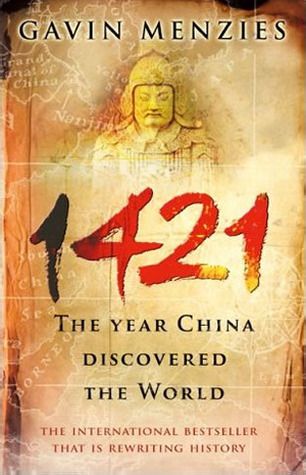1421 The Year China Discovered the World
On March 8, 1421, the largest fleet the world had ever seen set sail from China to "proceed all the way to the ends of the earth to collect tribute from the barbarians beyond the seas." When the fleet returned home in October 1423, the emperor had fallen, leaving China in political and economic chaos. The great ships were left to rot at their moorings and the records of their journeys were destroyed. Lost in the long, self-imposed isolation that followed was the knowledge that Chinese ships had reached America seventy years before Columbus and had circumnavigated the globe a century before Magellan. And they colonized America before the Europeans, transplanting the principal economic crops that have since fed and clothed the world.
On 8 March 1421, the largest fleet the world had ever seen set sail from China. The ships, some nearly five hundred feet long, were under the command of Emperor Zhu Di's loyal eunuch admirals. Their orders were 'to proceed all the way to the end of the earth'.
The voyage would last for two years and by the time the fleet returned, China was beginning its long, self-imposed isolation from the world it had so recently embraced. And so the great ships were left to rot, and the records of their journey destroyed. And with them, the knowledge that the Chinese had circumnavigated the globe a century before Magellan, reached America seventy years before Columbus, and Australia three hundred and fifty years before Cook.
The result of fifteen years research, 1421 is Gavin Menzies' enthralling account of this remarkable journey, of his discoveries and the persuasive evidence to support them: ancient maps, precise navigational knowledge, astronomy, surviving accounts of Chinese explorers and later European navigators as well as the traces the fleet left behind.
| Author | Gavin Menzies |
|---|---|
| Publisher | Bantam Books |
| Place | London |
| Year | 2003 |
| ISBN | 9780553815221 |
| Binding | Paperback |
| Condition | Good |
| Comments | Inscription on dedication page. |
How we describe the condition of our books
We are very proud of the condition of the books we sell (please read our testimonials to find out more!)
New: Exactly as it says.
As New: Pretty much new but shows small signs of having been read; inside it will be clean without any inscriptions or stamps; might contain a remainder mark.
Very Good: Might have some creases on the spine; no hard cracks; maybe slight forward lean and short inscription inside; perhaps very minor bumping on the corners of the book; inside clean but the page edges might be slightly yellowed.
Good: A few creases on the spine, perhaps a forward lean, bumping on corners or shelfwear; maybe an inscription inside or some shelfwear or a small tear or two on the dustjacket; inside clean but page edges might be somewhat yellowed.
Fair: In overall good condition, might have a severe forward lean to the spine, an inscription, bumping to corners; one or two folds on the covers and yellowed pages; in exceptional cases these books might contain some library stamps and stickers or have neat sticky tape which was used to fix a short, closed tear.
Poor: We rarely sell poor condition books, unless the books are in demand and difficult to find in a better condition. Poor condition books are still perfect for a good read, all pages will be intact and none threatening to fall out; most probably a reading copy only.


